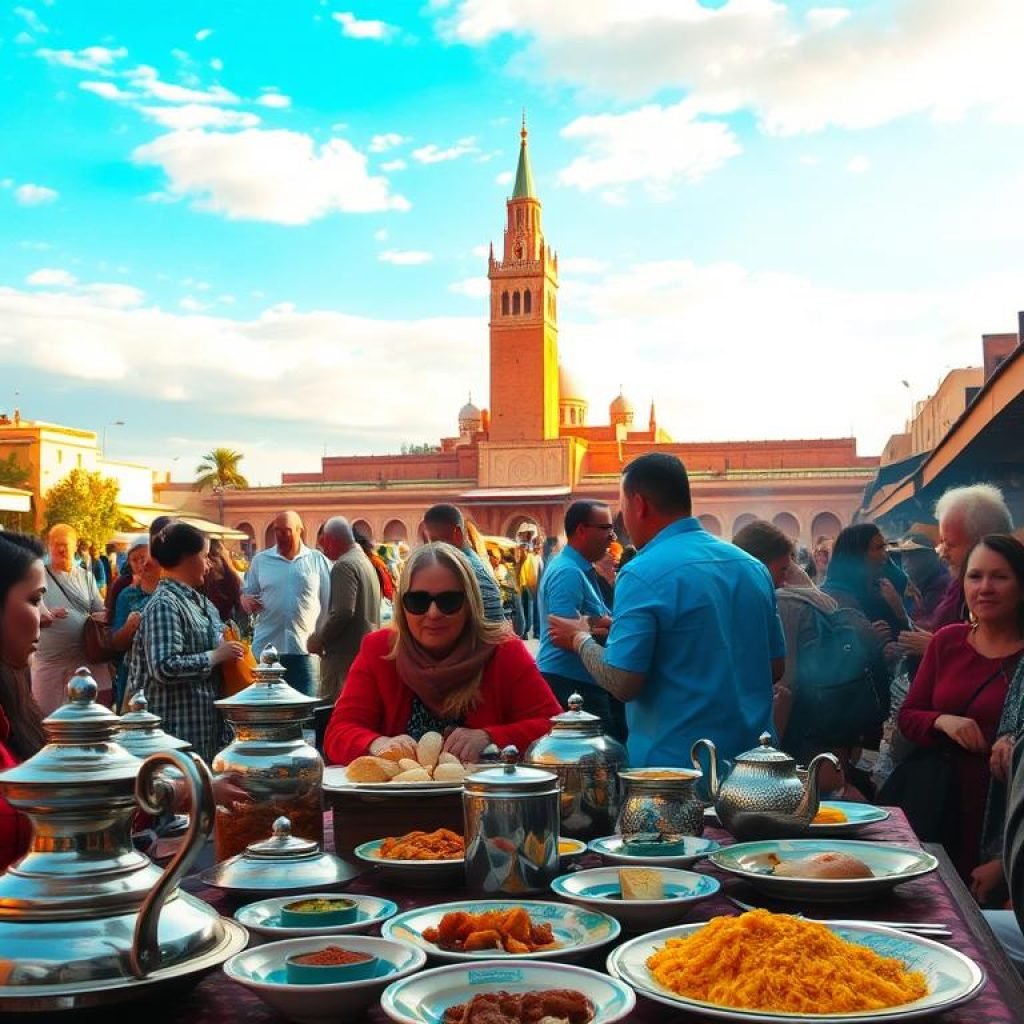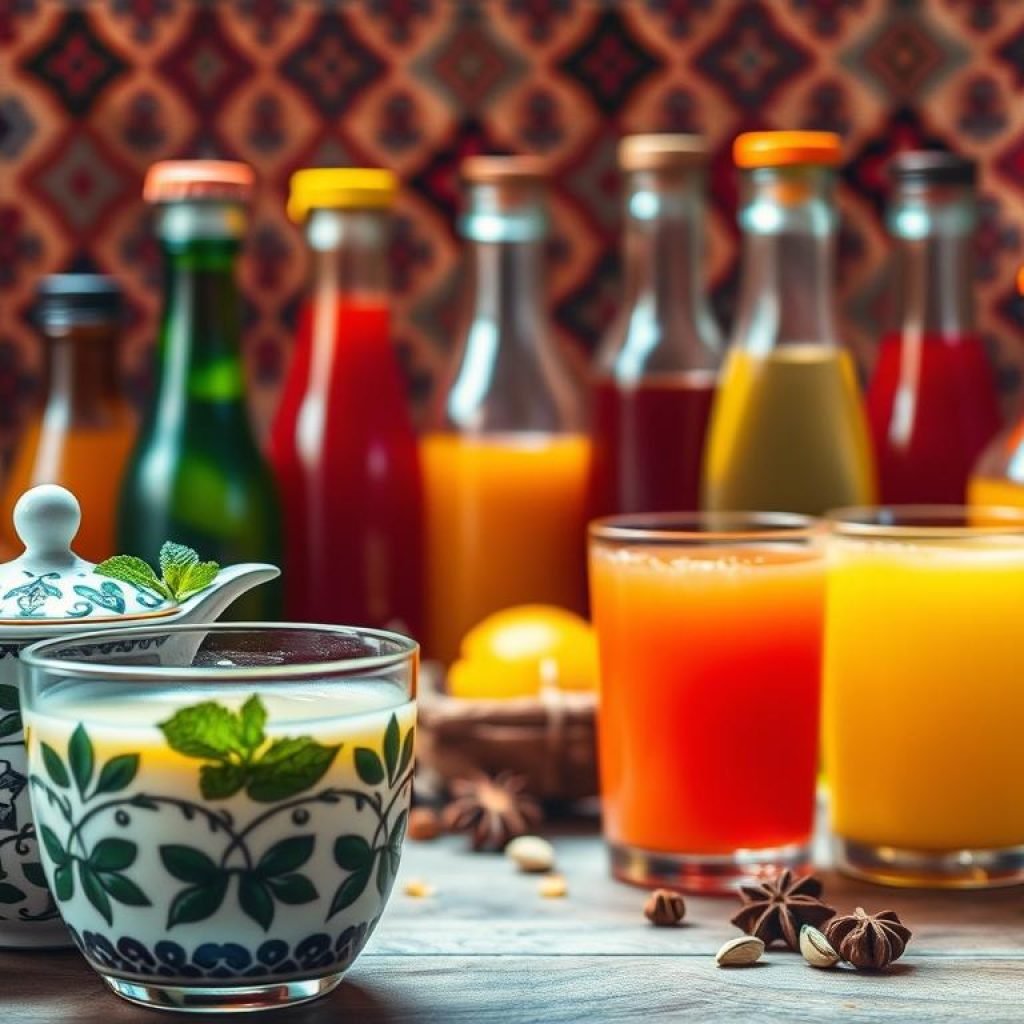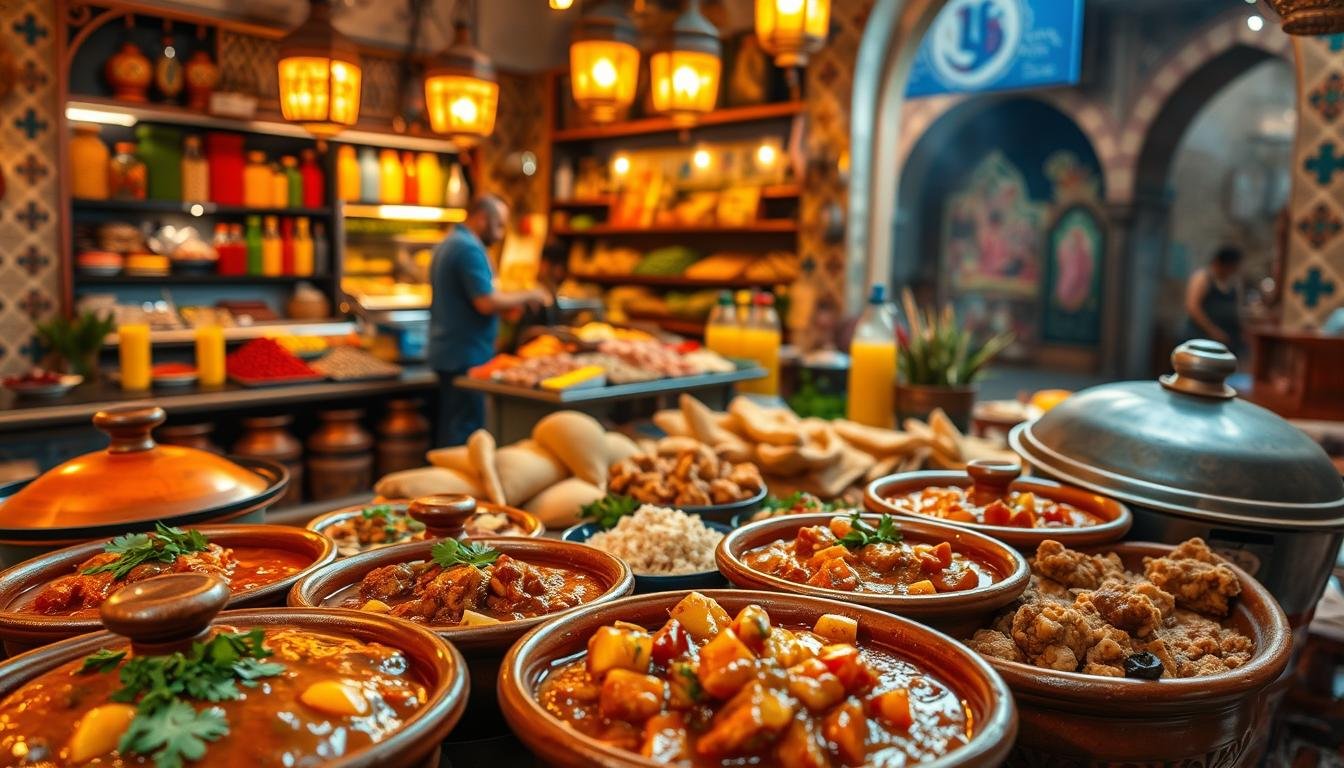Imagine walking through Morocco’s lively streets, filled with the smells of tagines and couscous. You’re curious about what makes a real Moroccan food experience. To eat like a local, dive into the local culture and food. Moroccan cuisine is a mix of unique and familiar tastes, making it exciting for visitors.
For more tips on traveling in Morocco, check out Moroccan cuisine and culture. It has great advice on enjoying the local food scene.
Key Takeaways
- Immerse yourself in local culture to have an authentic Moroccan food experience
- Try traditional dishes like tagines, couscous, and harira to taste the unique flavors of Morocco
- Respect local customs and dining etiquette to make the most of your experience
- Explore local markets and food stalls to discover the diversity of Moroccan cuisine
- Be mindful of food safety precautions to ensure a healthy and enjoyable experience
- Learn about the importance of shared meals and hospitality in Moroccan culture
- Discover the role of spices and ingredients in traditional Moroccan cooking
Discover Traditional Moroccan Cuisine
Traditional Moroccan dishes blend cultures like Andalusian Spain, Arabia, and France. This mix creates a unique and flavorful taste of Morocco. To truly experience Moroccan dining, try local favorites like tagines, couscous, and harira.
These dishes use a variety of ingredients, including meats, vegetables, and grains. They are often seasoned with spices like cumin, cinnamon, and ginger.
Spices are a key part of Moroccan cuisine. They add depth and complexity to the dishes. Cumin, cinnamon, and ginger are popular spices used in Moroccan cooking.
The mix of these spices gives Moroccan dishes a distinct taste. For an authentic dining experience, visit a local restaurant or café. There, you can try many traditional dishes and enjoy the warm hospitality of the Moroccan people.
Some must-try dishes include tagines, couscous, and harira. Tagines are slow-cooked stews with meat, vegetables, and dried fruits. Couscous is a traditional North African dish made from steamed semolina flour.
Harira is a hearty soup with lentils, chickpeas, and tomatoes. It’s often served as a starter or snack. These dishes are delicious and show Morocco’s rich culinary heritage. They are a must-try for anyone wanting to taste Morocco’s authentic flavors.
Understanding Moroccan Dining Etiquette
Dining in Marrakech is more than just eating. It’s about diving into the local food culture of Morocco. Traditional meals are shared, showing the importance of food in their culture. In fact, about 80% of Moroccan families eat from a big platter together.
Bread is a big deal in Morocco. It’s used to pick up food, and most meals come with it. Remember, always use your right hand when eating. Using your left hand is seen as rude.

The Importance of Shared Meals
Shared meals are key in Moroccan culture. They can last from 1.5 to 2 hours. This time is used to bond and make connections. About 70% of visitors find these meals enriching.
How to Use Bread and Utensils
Knowing how to use bread and utensils is crucial in Marrakech. Here are some tips:
- Always use your right hand when eating or passing items.
- Bread is used to scoop up food, so be sure to tear it into small pieces before using it.
- Respect local customs by not eating with your left hand, as this is considered impolite.
By following these tips, you’ll enjoy your meals more in Morocco. You’ll also get to experience the local food culture fully.
Exploring Local Markets and Food Stalls
Exploring local markets and food stalls in Morocco is a must for culinary adventures. The local food culture in Morocco is vibrant and diverse. You’ll find a wide range of delicious dishes to try, from traditional street food to fresh juices and snacks.
In cities like Fez, Marrakech, and Essaouira, street food stalls are open all day and night. For example, in Fez, you can try bissara, a traditional breakfast dish made from split broad beans. In Marrakech’s Mechoui Alley, lamb is cooked underground for five hours before being served.
To enjoy street food safely, research the vendor and avoid undercooked meat. Be mindful of food allergies too. This way, you can truly experience Morocco’s local food culture and have a memorable culinary adventure.
Some popular street food options include sardine sandwiches, mini-chicken kebabs, and snail soup. Prices start from just a few dirhams, making it easy to try many dishes. Exploring local markets and food stalls is an unforgettable experience for food lovers and anyone looking to dive into the local food culture in Morocco.
Embracing the Concept of ‘Slow Food’
When you Eat like a local in Morocco, you’ll find that meals are a time to slow down. The idea of “slow food” is big in Moroccan culture. Meals are seen as a chance to connect with others.
A traditional Moroccan meal is served at low, round tables. Everyone shares dishes, making dining a social event. For example, couscous takes five hours to cook just right. This slow cooking lets everyone enjoy each other’s company.
- Savor each bite, noticing the flavors and textures.
- Talk with your fellow diners, enjoying the meal’s social side.
- Take your time, making the meal a relaxed experience.
By embracing “slow food” and Eat like a local in Morocco, you’ll get the most out of Moroccan cuisine. So, breathe deeply, slow down, and enjoy the Moroccan food experience!
Sampling Moroccan Beverages
Authentic Moroccan dining is more than just food. It’s also about the drinks that go with it. You’ll find everything from mint tea to fresh fruit juices and smoothies.
Moroccan hospitality shines through in mint tea. It’s a big part of their culture. They pour tea from high up to make a frothy head, showing respect and welcome. Morocco is also known for its fresh orange juice, thanks to the country’s many oranges.
Looking for something different? Moroccan avocado smoothies are a hit, loved by health fans and vegans. They mix fresh avocados, oranges, and other fruits for a cool, healthy drink. You can also try traditional coffee, local wines, and Fes’s flag beer.

- Mint tea: a traditional tea made with spearmint and green tea
- Orange juice: freshly squeezed from the country’s abundant oranges
- Avocado smoothies: a refreshing and healthy drink made with avocados and other fruits
- Local wines: such as Clairet de Meknès and Guerrouane
- Flag beer: a popular beer from Fes
In Morocco, drinking is a big part of eating out. The wide range of drinks shows off the country’s rich food culture. Whether you want mint tea or an avocado smoothie, there’s something for everyone. It’s a true taste of Morocco and authentic dining.
Learning to Cook Moroccan Dishes
Exploring Morocco’s culinary scene is a fantastic way to dive into the local food culture. Learning to cook Moroccan dishes is a great way to do this. Cooking classes are perfect for discovering local ingredients and techniques.
Key ingredients to master include cumin, cinnamon, and ginger. These spices are essential in Moroccan cooking and can make your dishes taste amazing. You’ll also learn various cooking methods like grilling, stewing, and roasting. By taking a class, you’ll get hands-on experience with these ingredients and techniques.
Signing up for a cooking class is a great way to learn about Morocco’s food culture. You’ll discover traditional dishes and modern twists. With the right ingredients and techniques, you can make delicious Moroccan food at home. Enjoy the flavors of Morocco in your own kitchen.
Visiting Local Restaurants and Cafés
Exploring Marrakech’s dining scene lets visitors dive into Morocco’s rich food culture. You’ll find everything from traditional eateries to modern cafes. For a real taste of Marrakech, check out Dar Yacout and Sahbi Sahbi, two top spots.
Local spots stand out for their authenticity and affordability. They offer genuine Moroccan dishes at prices that won’t break the bank. Here are some tips to help you find the best places to eat:
- Seek out restaurants known for traditional Moroccan dishes like tagine and couscous.
- Compare prices to find the best deals in the area.
- Ask locals for their favorite places to eat. They know the best spots.
Supporting local businesses and trying authentic Moroccan food is key to experiencing Marrakech. The city’s lively food scene offers a memorable culinary adventure.
Finding Food Tours in Morocco
Food tours in Morocco are a great way to dive into the local food culture. You can pick from guided tours, cooking classes, and market visits. These options let you explore Moroccan cuisine’s flavors and ingredients.
A Marrakech food tour might include trying dishes like tagines and couscous. You’ll also visit local markets to see the spices and ingredients used in Moroccan cooking. Some tours even offer cooking classes, where you can learn to make traditional Moroccan dishes.
Types of Food Tours Available
There are many types of food tours in Morocco, including:
- Guided culinary tours, which offer a deep dive into Morocco’s local food culture
- Cooking classes, where you can learn to make traditional Moroccan dishes
- Market visits, where you can learn about the ingredients and spices used in Moroccan cooking
Benefits of Guided Culinary Experiences
Guided culinary experiences are a unique way to learn about Morocco’s food culture. With a knowledgeable guide, you’ll understand the ingredients, spices, and cooking techniques used in Moroccan cuisine.
Some popular tours include the Marrakech Street Food Tour and the Authentic Moroccan Food Tour. These tours let you try traditional Moroccan treats and learn about the local food culture.
By taking a food tour in Morocco, you can experience the local food culture and enjoy the culinary adventures. With many options available, there’s something for everyone.
Tips for Dietary Restrictions
Exploring Morocco’s food scene is exciting, but remember to consider dietary needs. If you’re vegetarian, vegan, or have food allergies, finding the right food can be a fun challenge. With some planning, you can eat like a local in Morocco and still meet your dietary requirements.
Vegetarians and vegans will find plenty of options in Morocco. You can enjoy couscous, tajine, and harira soup, all made without meat. Many places now offer special vegetarian and vegan dishes, making it easier to find something you like.
If you’re gluten-sensitive or have celiac disease, talking to your server is crucial. Ask about gluten in sauces and if they can avoid cross-contamination. Look for gluten-free bakeries and stores to make sure you have a great time eating.
No matter your diet, Morocco’s food is a treat for the taste buds and a peek into the culture. Being open and flexible will lead you to many delicious discoveries. You’ll want to try more and more of the local cuisine.




Comment (0)